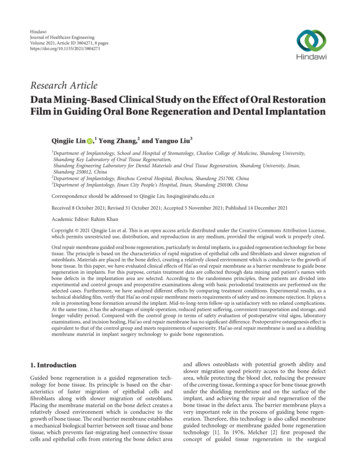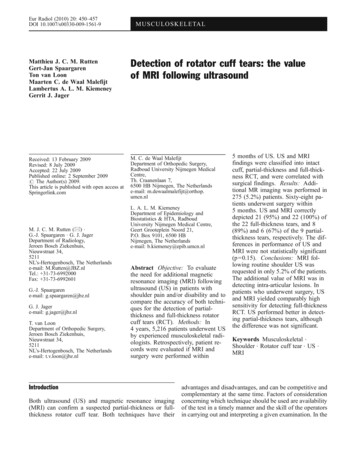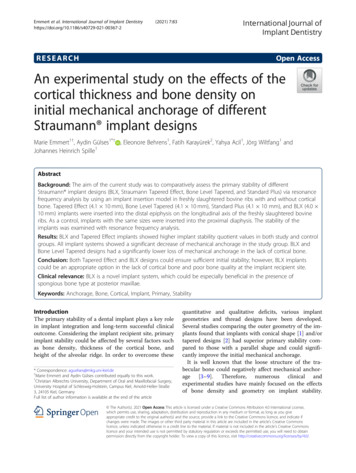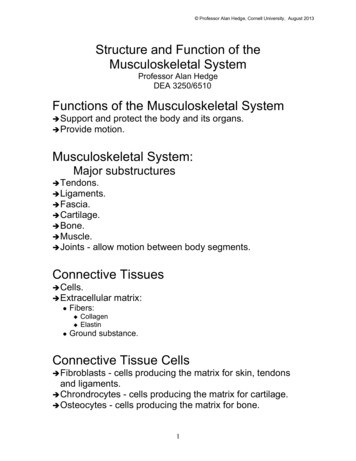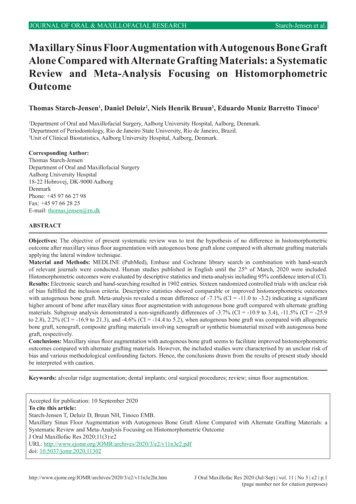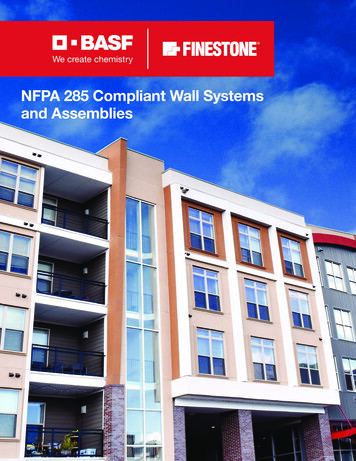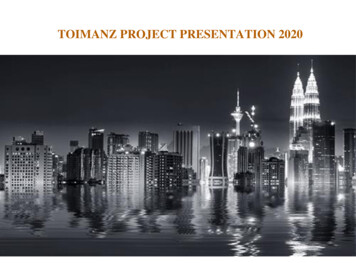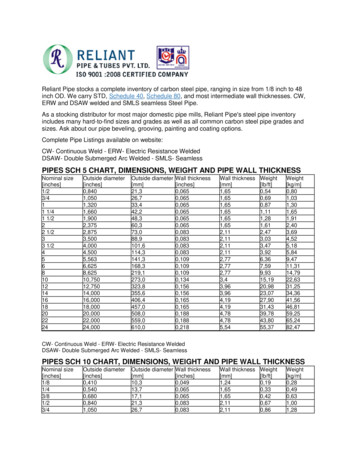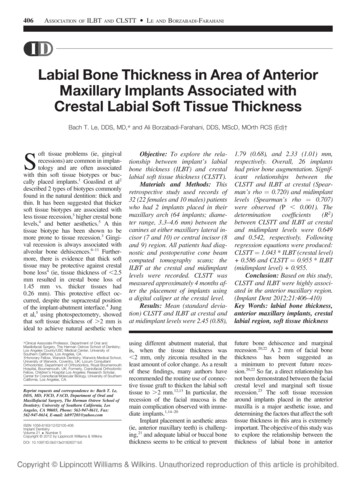
Transcription
406ASSOCIATIONOFILBTANDCLSTT LEANDBORZABADI-FARAHANILabial Bone Thickness in Area of AnteriorMaxillary Implants Associated withCrestal Labial Soft Tissue ThicknessBach T. Le, DDS, MD,* and Ali Borzabadi-Farahani, DDS, MScD, MOrth RCS (Ed)†oft tissue problems (ie, gingivalrecessions) are common in implantology and are often associatedwith thin soft tissue biotypes or buccally placed implants.1 Goaslind et al2described 2 types of biotypes commonlyfound in the natural dentition: thick andthin. It has been suggested that thickersoft tissue biotypes are associated withless tissue recession,3 higher crestal bonelevels,4 and better aesthetics.5 A thintissue biotype has been shown to bemore prone to tissue recession.3 Gingival recession is always associated withalveolar bone dehiscences.6–11 Furthermore, there is evidence that thick softtissue may be protective against crestalbone loss4 (ie, tissue thickness of ,2.5mm resulted in crestal bone loss of1.45 mm vs. thicker tissues had0.26 mm). This protective effect occurred, despite the supracrestal positionof the implant-abutment interface.4 Junget al,5 using photospectometry, showedthat soft tissue thickness of .2 mm isideal to achieve natural aesthetic whenSObjective: To explore the relationship between implant’s labialbone thickness (ILBT) and crestallabial soft tissue thickness (CLSTT).Materials and Methods: Thisretrospective study used records of32 (22 females and 10 males) patientswho had 2 implants placed in theirmaxillary arch (64 implants; diameter range, 3.3–4.6 mm) between thecanines at either maxillary lateral incisor (7 and 10) or central incisor (8and 9) region. All patients had diagnostic and postoperative cone beamcomputed tomography scans; theILBT at the crestal and midimplantlevels were recorded. CLSTT wasmeasured approximately 4 months after the placement of implants usinga digital caliper at the crestal level.Results: Mean (standard deviation) CLSTT and ILBT at crestal andat midimplant levels were 2.45 (0.88),1.79 (0.68), and 2.33 (1.01) mm,respectively. Overall, 26 implantshad prior bone augmentation. Significant relationships between theCLSTT and ILBT at crestal (Spearman’s rho ¼ 0.720) and midimplantlevels (Spearman’s rho ¼ 0.707)were observed (P , 0.001). Thedeterminationcoefficients(R2)between CLSTT and ILBT at crestaland midimplant levels were 0.649and 0.542, respectively. Followingregression equations were produced:CLSTT ¼ 1.043 * ILBT (crestal level) 0.586 and CLSTT ¼ 0.955 * ILBT(midimplant level) 0.955.Conclusion: Based on this study,CLSTT and ILBT were highly associated in the anterior maxillary region.(Implant Dent 2012;21:406–410)Key Words: labial bone thickness,anterior maxillary implants, crestallabial region, soft tissue thickness*Clinical Associate Professor, Department of Oral andMaxillofacial Surgery, The Herman Ostrow School of Dentistry;Los Angeles County/USC Medical Center, University ofSouthern California, Los Angeles, CA.†Honorary Fellow, Warwick Dentistry, Warwick Medical School,University of Warwick, Coventry, UK; Locum ConsultantOrthodontist, Department of Orthodontics, Royal BournemouthHospital, Bournemouth, UK; Formerly, Craniofacial OrthodonticFellow, Children’s Hospital Los Angeles; Research Scholar,Center for Craniofacial Molecular Biology, University of SouthernCalifornia, Los Angeles, CA.using different abutment material, thatis, when the tissue thickness was,2 mm, only zirconia resulted in theleast amount of color change. As a resultof these findings, many authors haverecommended the routine use of connective tissue graft to thicken the labial softtissue to .2 mm.12,13 In particular, therecession of the facial mucosa is themain complication observed with immediate implants.1,14–20Implant placement in aesthetic areas(ie, anterior maxillary teeth) is challenging,21 and adequate labial or buccal bonethickness seems to be critical to preventfuture bone dehiscence and marginalrecession.20,22 A 2 mm of facial bonethickness has been suggested asa minimum to prevent future recession.20,22 So far, a direct relationship hasnot been demonstrated between the facialcrestal level and marginal soft tissuerecession.23 The soft tissue recessionaround implants placed in the anteriormaxilla is a major aesthetic issue, anddetermining the factors that affect the softtissue thickness in this area is extremelyimportant. The objective of this study wasto explore the relationship between thethickness of labial bone in anteriorReprint requests and correspondence to: Bach T. Le,DDS, MD, FICD, FACD, Department of Oral andMaxillofacial Surgery, The Herman Ostrow School ofDentistry; University of Southern California, LosAngeles, CA 90603, Phone: 562-947-8611, Fax:562-947-8614, E-mail: leb97201@yahoo.comISSN 1056-6163/12/02105-406Implant DentistryVolume 21 Number 5Copyright 2012 by Lippincott Williams & WilkinsDOI: 10.1097/ID.0b013e31826371b5
IMPLANT DENTISTRY / VOLUME 21, NUMBER 5 2012407maxillary implants and the crestal labialsoft tissue thickness (CLSTT).MATERIALSANDMETHODSThe material for this retrospectivestudy comprised provisional study castsand sectional cone beam computedtomography (CT) images of 32 (22females and 10 males) patients who weretreated in the private practice of the firstauthor. The material has been anonymized by the first author so that patients’information cannot be identified. As such,ethical approval for this study was notneeded. These selected patients had tohave 2 implants in the maxilla placed atthe same time, between the canines ateither maxillary lateral incisor (7 and10) or central incisor (8 and 9) region.To be included in the study, patients musthave had soft tissue casts available at thetime of temporization. The provisionalstypically arrived with the soft tissue moulage in the cast. Those implants for whichsoft tissue casts were not available or notobtainable from the laboratory wereexcluded. Overall, 64 implants wereplaced. Implant diameters ranged from3.3 to 4.6 mm. The implant position wasdetermined using the cone beam CTimage (Picasso Duo; VATech, SouthKorea) and by measuring the total ridgewidth and comparing the diameter of theimplant and the surrounding bone thickness (labial bone, palatal bone). Allpatients had diagnostic (pre) and postoperative sectional cone beam CT scans.Using the sectional cone beam CTimages, the labial bone thickness at thecrestal (2 mm from the bone crest) andmidimplant levels were measured andrecorded (Fig. 1). The CLSTT wasmeasured using a digital caliper(Mitutoyo) on study casts, at the time oftemporization, at the crestal level (Fig. 2).Prior implant site augmentation was alsorecorded. The measurements ofCLSTT were performed approximately4 months after the placement of implants.All measurements of the CLSTT, labialbone thickness at the crestal, and that atthe midimplant levels were performed bya single examiner (B.T.L.) and reconfirmed by the other investigator (A.B.-F.).Statistical AnalysisData for the present study wereentered into the Excel and subsequentlyFig. 1. Tomogram of 2 implants (8 and 9) illustrating the positions (2 mm from the bone crestand at the midimplant level) of the measurements for the thickness of the maxillary labial bone.midimplant levels were also calculated.Regression equations for the data werealso created. Any P , 0.05 was considered as statistically significant.RESULTSFig. 2. CLSTT measurements performed onthe study casts at the time of temporization.transferred to the SPSS software(Statistical Package for Social SciencesVersion 17.0; SPSS, Inc, Chicago, IL).CLSTT data were gender comparedusing the independent t test. Implantswere divided into 2 groups based onprior bone augmentation (with boneaugmentation and without). The CLSTTand labial bone thickness at the crestaland midimplant levels were exposed toindependent t test to explore any significant differences with regards to boneaugmentation. The Spearman correlationcoefficients (rho) were used to assess therelationship between the implant’s labialbone thickness (at the crestal and midimplant levels) and the CLSTT. Scatterplots were used to graphically explorethe relationship between the implant’slabial bone thickness and the CLSTT.The coefficients of determination (R2)between the CLSTT and the implant’slabial bone thickness at the crestal andThe mean 6 SD for CLSTT andlabial bone thickness at the crestal andmidimplant levels were 2.45 6 0.88,1.79 6 0.68, and 2.33 6 1.01 mm, respectively. Overall, 26 implants hadprior bone augmentation (Table 1). TheCLSTT and labial bone thickness at thecrestal and midimplant levels were 0.17,0.07, and 0.23 mm, respectively, in thegroup without prior bone augmentation;however, the differences were not significant (P . 0.05). The independentt test revealed no significant gender difference for the CLSTT (P . 0.05) (2.466 0.88 mm and 2.43 6 0.90 mm forfemale and male patients, respectively).There were statistically significantassociations between the CLSTT andthe labial bone thickness at thecrestal (rho ¼ 0.720; P ¼ 0.000) andmidimplant (rho ¼ 0.707; P ¼ 0.000)levels. Figures 3 and 4 show the scatterplot of the implant’s labial bone thickness (at the crestal and midimplantlevels) plotted against the CLSTT.The coefficients of determination (R2)between the CLSTT and the implant’slabial bone thickness at the crestal andmidimplant levels were 0.649 andCLSTT 5 1:043*implant’s labial bone thickness at the crestal level þ 0:586CLSTT 5 0:955*implant’s labial bone thickness at the mid-implant level þ 0:955:
408ASSOCIATIONOFILBTANDCLSTT LEANDBORZABADI-FARAHANITable 1. The CLSTT, and Labial Bone Thickness at Crestal and Midimplant Levels inImplants With and Without Prior Bone AugmentationLabial bone thickness at crestal levelLabial bone thickness at midimplant levelCLSTTPrior BoneAugmentationnYesNoYesNoYesNo263826382638Mean (SD), (0.91)(0.87)Fig. 3. Scatter plot showing the relationship between the CLSTT and the labial bone thickness at the crestal level. Solid line shows the regression lines.Fig. 4. Scatter plot showing the relationship between the CLSTT and the labial bone thickness at the midimplant level. Sold line shows the regression lines.0.542, respectively. The followingregression equations were produced:DISCUSSIONPrevious studies have confirmedthat the level or thickness of the bonearound implants can affect the softtissue profile. For instance, the contactpoint location and the height of theinterproximal crestal bone for a tooth orimplant can influence the height of theinterdental papilla.24–28 In general, theinterproximal papillae are expected tofill the embrasure area if the distancebetween the contact points to the interproximal crestal bone is 5 mm or less.Another example is the interimplantdistance or distance between theimplants and adjacent teeth. For aesthetic reasons and proper appearanceof the interproximal papilla, an interimplant and an interimplant-tooth distances of 3 mm and 3 to 4 mm have beenrecommended, respectively.28–31A thin soft tissue biotype of,2-mm thickness has often been associated with thinner underlying bone,angular bone defects, increased susceptibility to the loss of papilla after immediate implant placement, and is moreprone to recession in response to traumaand bacteria than a thick biotype.32Consequently, a thin soft tissue biotypeaffects the implant success, particularly when immediate loading isthe treatment of choice.19 A minimumbuccal bone thickness of 2 mm is alsonecessary for the maintenance of thebone level, and any thickness belowthat demand hard tissue bone augmentation.20,22,32,33 However, the importance of soft tissue biotype for theprevention of gingival recession hasbeen questioned recently.13,34In the present study, high correlations (0.720 and 0.707) between theCLSTT of anterior maxillary implantsand the thickness of the underlyingbone in that area confirmed that thecovering soft tissue was heavily influenced by the labial bone thickness.In other words, the coefficient ofdetermination between the CLSTTand the implant’s labial bone thicknessat the crestal and midimplant levels andwere 0.649 and 0.542, respectively.Therefore, approximately 64.9% or
IMPLANT DENTISTRY / VOLUME 21, NUMBER 5 201254.2% of the variation in the data forCLSTT was explained by the implant’slabial bone thickness at the crestal ormidimplantlevels,respectively.According to the present findings, adequate labial bone thickness at thecrestal level (2 mm) of anterior maxillary implants was associated with sufficient CLSTT (;2.7 mm). This is animportant clinical finding because traditionally, soft tissue graft has beenused to enhance the thin soft tissue coverage around the implant.35 For thepresent study, we used a sectional conebeam CT scan36 that can offer someinteresting advantages such as comparable level radiation to conventionalradiographs, relatively reasonable cost,and the ability to investigate the3-dimensional image, which is lackingin conventional 2-dimensional radiographs.37–39 Cone beam CT scanproved to be reliable in quantitativelyassessing the covering buccal bonethickness in natural teeth with high precision.40–43 A potential limitation of thestudy can be the difficulty in measuringthe thin buccal plate facing a metallicobject such as an implant. However,this method has been used previously,44 and it is the only noninvasiveapproach to investigate the relationshipbetween covering soft tissue and bonethickness.A mean labial gingival recessionof 0.5 to 1 mm around single implants,which is partially because of the boneremodeling after implant surgery, hasbeen reported and seems to be a common finding after implant restorations.1,18,45–49 Over 1 year betweensingle implant placement and the second-stage surgery, a mean reduction infacial bone thickness and facial boneheight of 0.4 mm and 0.7 mm havebeen reported, respectively, in the periimplant tissues of the anterior maxillary region, which resulted in a meanapical displacement of 0.6 mm for thelabial soft tissue margin.48 Consequently, a limitation of this study is thatwe measured the CLSTT around anterior maxillary implants and the thicknessof the underlying bone after 4 months,and there may be some changes afterthis time point. Future long-term studiescan investigate these changes.CONCLUSIONThe findings in this study suggest theCLSTT around implants is significantlyassociated with the labial bone thicknessin anterior maxillary region. In otherwords, the thicker the bone, thethicker the CLSTT around implants andvice versa.DISCLOSUREThe authors claim to have nofinancial interest, either directly orindirectly, in the products or information mentioned in the article.ACKNOWLEDGMENTImplants placed in this study were20 Astra, 18 Strauman, 12 BHZ, 6 Zimmer, 6 Biomet, and 2 Lifecore implants.Dr Borzabadi-Farahani was supportedby a research grant from the EuropeanOrthodontic Society and a PostdoctoralResearch Fellowship from the Children’s Hospital Los Angeles.REFERENCES1. Evans CD, Chen ST. Esthetic outcomes of immediate implant placements.Clin Oral Implants Res. 2008;19:73–80.2. Goaslind GD, Robertson PB, MahanCJ, et al. Thickness of facial gingiva.J Periodontol. 1977;48:768–771.3. Bengazi F, Wennström JL, Lekholm U.Recession of the soft tissue margin atoral implants. A 2-year longitudinal prospective study. Clin Oral Implants Res. 1996;7:303–310.4. Linkevicius T, Apse P, Grybauskas S,et al. The influence of soft tissue thicknesson crestal bone changes around implants:a 1-year prospective controlled clinical trial.Int J Oral Maxillofac Implants. 2009:24;712–719.5. Jung RE, Sailer I, Hämmerle CH,et al. In vitro color changes of soft tissuescaused by restorative materials. IntJ Periodontics Restorative Dent. 2007;27:251–257.6. Ngom PI, Diagne F, Benoist HM,et al. Intraarch and interarch relationshipsof the anterior teeth and periodontal conditions. Angle Orthod. 2006;76:236–242.7. Fuhrmann R. Three-dimensional evaluation of periodontal remodeling duringorthodontic treatment. Semin Orthod.2002;8:23–28.8. Wennstrom JL. Mucogingival therapy. Ann Periodontol. 1996;1:671–701.4099. Kassab MM, Cohen RE. The etiology and prevalence of gingival recession.J Am Dent Assoc. 2003;134:220–225.10. Patel M, Nixon PJ, Chan MF.Gingival recession: part 1. Aetiology andnon-surgical management. Br Dent J.2011;211:251–254.11. Richman C. Is gingival recessiona consequence of an orthodontic toothsize and/or tooth position discrepancy?“A paradigm shift”. Compend Contin EducDent. 2011;32:62–69.12. Esposito M, Maghaireh H, GrusovinMG, et al. Interventions for replacing missingteeth: management of soft tissues for dentalimplants. Cochrane Database Syst Rev.2012;(2):CD006697.13. Chen ST, Darby IB, Reynolds EC.A prospective clinical study of nonsubmerged immediate implants: clinicaloutcomes and esthetic results. Clin OralImplants Res. 2007;18:552–562.14. Chen ST, Buser D. Clinical andesthetic outcomes of implants placed inpostextraction sites. Int J Oral MaxillofacImplants. 2009;24(suppl):186–217.15. Chen ST, Darby IB, Adams GG,et al. A prospective clinical study of boneaugmentation techniques at immediateimplants. Clin Oral Implants Res. 2005;16:176–184.16. Lindeboom JA, Tjiook Y, Kroon FH.Immediate placement of implants in periapical infected sites: A prospective randomized study in 50 patients. Oral SurgOral Med Oral Pathol Oral Radiol Endod.2006;101:705–710.17. Kan JYK, Rungcharassaeng K,Sclar A, et al. Effects of the facial osseousdefect morphology on gingival dynamicsafter immediate tooth replacement andguided bone regeneration: 1-year results.J Oral Maxillofac Surg. 2007;65(7 suppl 1)13–19.18. De Rouck T, Collys K, Cosyn J.Immediate single tooth implants in theanterior maxilla: a 1-year case cohortstudy on hard and soft tissue response.J Clin Periodontol. 2008;35:649–657.19. Chen ST, Darby IB, Reynolds EC,et al. Immediate implant placement postextraction without flap elevation. J Periodontol.2009;80:163–172.20. Borzabadi-Farahani A. Orthodonticconsiderations in restorative managementof hypodontia patients with endosseousimplants. J Oral Implantol. [publishedonline ahead-of-print July 5, 2011]. doi:10.1563/AAID-JOI-D-11-00022.21. Buser D, Martin W, Belser UC.Optimizing esthetics for implant restorations in the anterior maxilla: anatomic andsurgical considerations. Int J Oral Maxillofac Implants. 2004;19(suppl):43–61.22. Spray JR, Black CG, Morris HF,et al. The influence of bone thickness on
410ASSOCIATIONOFILBTANDCLSTT LEfacial marginal bone response: stage 1placement through stage 2 uncovering.Anna Periodontol. 2000;5:119–128.23. Nisapakultorn K, Suphanantachat S,Silkosessak O, et al. Factors affectingsoft tissue level around anterior maxillarysingle-tooth implants. Clin Oral ImplantsRes. 2010;21:662–670.24. Tarnow DP, Magner AW, Fletcher P.The effect of the distance from the contactpoint to the crest of bone on the presenceor absence of the interproximal dentalpapilla. J Periodontol. 1992;63:995–996.25. ChoquetV,HermansM,Adriaenssens P, et al. Clinical and radiographic evaluation of the papilla level adjacent to single-tooth dental implants.A retrospective study in the maxillary anterior region. J Periodontol. 2001;72:1364–1371.26. Ryser MR, Block MS, Mercante DE.Correlation of papilla to crestal bone levelsaround single tooth implants in immediateor delayed crown protocols. J Oral Maxillofac Surg. 2005;63:1184–1195.27. Palmer RM, Farkondeh N, PalmerPJ, et al. Astra tech single-tooth implants:an audit of patient satisfaction and soft tissue form. J Clin Periodontol. 2007;34:633–638.28. Lops D, Chiapasco M, Rossi A,et al. Incidence of inter-proximal papillabetween a tooth and an adjacent immediate implant placed into a fresh extractionsocket: 1-year prospective study. Clin OralImplants Res. 2008;19:1135–1140.29. Esposito M, Ekestubbe A, GrondahlK. Radiological evaluation of marginal boneloss at tooth surfaces facing single Brånemark implants. Clin Oral Implants Res.1993;4:151–157.30. Tarnow DP, Cho SC, Wallace SS.The effect of inter-implant distance onthe height of inter-implant bone crest.J Periodontol. 2000;71:546–549.31. Romeo E, Lops D, Rossi A, et al.Surgical and prosthetic management ofinterproximal region with single-implantrestorations: 1-year prospective study.J Periodontol. 2008;79:1048–1055.ANDBORZABADI-FARAHANI32. Lee A, Fu JH, Wang HL. Soft tissuebiotype affects implant success. ImplantDent. 2011;20:e38–e47.33. Le B, Burstein J. Esthetic grafting forsmall volume hard and soft tissue contourdefects for implant site development.Implant Dent. 2008;17:136–141.34. van Kesteren CJ, Schoolfield J,West J, et al. A prospective randomizedclinical study of changes in soft tissueposition following immediate and delayedimplant placement. Int J Oral MaxillofacImplants. 2010;25:562–570.35. Kan JY, Rungcharassaeng K,Lozada JL. Bilaminar subepithelial connective tissue grafts for immediate implantplacement and provisionalization in theesthetic zone. J Calif Dent Assoc. 2005;33:865–871.36. Benavides E, Rios HF, Ganz SD,et al. Use of cone beam computed tomography in implant dentistry: the International Congress of Oral Implantologistsconsensus report. Implant Dent. 2012;21:78–86.37. De Vos W, Casselman J, SwennenGR. Cone-beam computerized tomography (CBCT) imaging of the oral and maxillofacial region: a systematic review of theliterature. Int J Oral Maxillofac Implants.2009;38:609–625.38. Scarfe WC, Farman AG, Levin MD,et al. Essentials of maxillofacial cone beamcomputed tomography. Alpha Omegan.2010;103:62–67.39. Behneke A, Burwinkel M, Knierim K,et al. Accuracy assessment of cone beamcomputed tomography-derived laboratorybased surgical templates on partially edentulous patients. Clin Oral Implant Res. 2012;23:137–143.40. Timock AM, Cook V, McDonald T,et al. Accuracy and reliability of buccalbone height and thickness measurementsfrom cone-beam computed tomographyimaging. Am J Orthod Dentofacial Orthop.2011;140:734–744.41. Januario AL, Duarte WR, BarrivieraM, et al. Dimension of the facial bone wallin the anterior maxilla: a cone-beam com-puted tomography study. Clin OralImplants Res. 2011;22:1168–1171.42. Braut V, Bornstein MM, Belser U,et al. Thickness of the anterior maxillaryfacial bone wall-a retrospective radiographic study using cone beam computedtomography. Int J Periodontics RestorativeDent. 2011;31:125–131.43. Nowzari H, Molayem S, Chiu CH,et al. Cone beam computed tomographicmeasurement of maxillary central incisorsto determine prevalence of facial alveolarbone width 2 mm. Clin Implant DentRelat Res [published online ahead-of-printMay 11, 2010]. doi:10.1111/j.1708-8208.2010.00287.x.44. Roe P, Kan JY, Rungcharassaeng K,et al. Horizontal and vertical dimensionalchanges of peri-implant facial bone followingimmediate placement and provisionalizationof maxillary anterior single implants: a 1-yearcone beam computed tomography study.Int J Oral Maxillofac Implants. 2012;27:393–400.45. Chang M, Wennstrom JL, Odman P,et al. Implant supported single-tooth replacements compared to contralateral naturalteeth. Crown and soft tissue dimensions.Clin Oral Implants Res. 1999;10:185–194.46. Grunder U. Stability of the mucosaltopography around single-tooth implantsand adjacent teeth: 1-year results. IntJ Periodont Restorative Dent. 2000;20:11–17.47. Kan JY, Rungcharassaeng K,Lozada J. Immediate placement and provisionalization of maxillary anterior singleimplants: 1-year prospective study. IntJ Oral Maxillofac Implants. 2003;18:31–39.48. Cardaropoli G, Lekholm U,Wennstrom JL. Tissue alterations atimplant-supported single-tooth replacements: a 1-year prospective clinical study.Clin Oral Implants Res. 2006;17:165–171.49. Jemt T, Ahlberg G, Henriksson K,et al. Changes of anterior clinical crownheight in patients provided with singleimplant restorations after more than15 years of followup. Int J Prosthodont.2006;19:455–461.
main complication observed with imme-diate implants.1,14-20 Implant placement in aesthetic areas (ie, anterior maxillary teeth) is challeng-ing,21 and adequate labial or buccal bone thickness seems to be critical to prevent future bone dehiscence and marginal recession.20,22 A 2 mm of facial bone thickness has been suggested as

